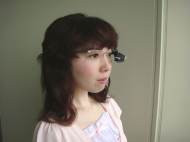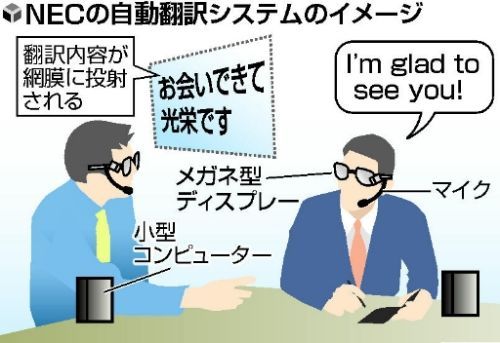NEC unveils their Retinal Imaging Display named Tele Scouter
 After writing about augmented reality glasses, the potential of see-through LED displays, and SixthSence, and even announcing the potential of retinal displays, we’re going to write about several Retinal Imaging Display devices meant to enhance our living in some manner. According to Japanese manufacturer NEC, foreign language dictionaries could be a thing of the past. They unveiled a pair of glasses that can automatically translate spoken words and phrases.
After writing about augmented reality glasses, the potential of see-through LED displays, and SixthSence, and even announcing the potential of retinal displays, we’re going to write about several Retinal Imaging Display devices meant to enhance our living in some manner. According to Japanese manufacturer NEC, foreign language dictionaries could be a thing of the past. They unveiled a pair of glasses that can automatically translate spoken words and phrases.
The Tele Scouter glasses (page in Japanese language) feature a compact microphone and camera, which picks up the foreign-language conversation. This audio recording is then relayed to a small computer worn on the user’s waist, which transmits the information to a remote server. The server translates the words from speech to text, and transmits it back to the glasses, where the translated phrase is then appears on a tiny retinal display, providing the wearer with a transcript of the conversation in their own language.
The system is designed to be compact and lightweight, so it can be comfortably worn for long periods. The retinal display projects the text in the wearer’s peripheral vision, enabling the user to maintain eye contact with whoever they’re speaking to. The developers claim its battery power consumption is low, so it is able to work in long intervals.
The Tele Scouter is currently still a prototype, although NEC plans to start selling the system to businesses next year. The Japanese manufacturer admits that the device’s translation capabilities are limited at the moment, so the device will be marketed as a wearable, hands-free data display. NEC predicts that it could be used by engineers and technicians to view user guides or manuals while installing and repairing hardware.
On the other hand, they also predicted the price for this hip gadget, and it won’t be anything near to accessible (Tele Scouter system capable of supporting up to 30 users will cost nearly $8.5M). Its design isn’t great either, even the similarly looking pair of glasses from Brother (we’re going to write about those in our next article) is a bit sleeker, but still far from looking good.
The concept of glasses meant for translating isn’t great either. If they do develop such an algorithm, they should implement it into text-to-speech software with ability to adjust the volume and the voice color of the translation. With the progress of the technology and computing power, we could be looking at the first versions of universal translators, but we are currently not even close to their realization. They should focus their translation plans on that field, and develop their glasses to display augmented reality or enhanced relevant information of the world around us.










Leave your response!